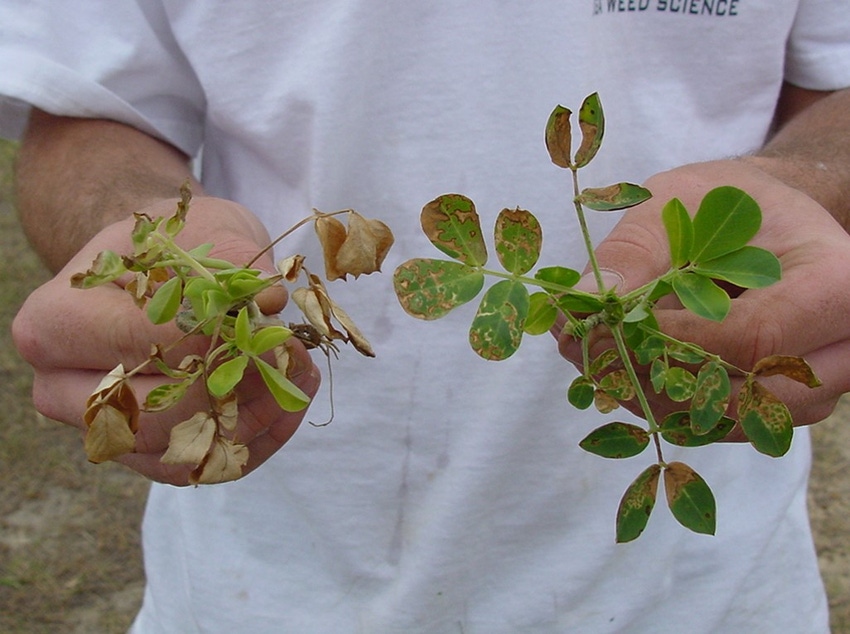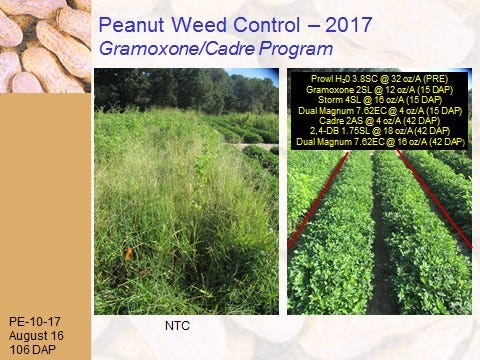May 14, 2018

Southeastern growers will soon be making the decision whether to spray their peanut crop with paraquat. This is colloquially known as a “cracking” spray.
With an allude to Willie Shakespeare’s Hamlet, a phrase comes to mind: “To burn or not to burn; that is the question?”
Paraquat has been around for a long time. In fact, it is older than I am. It was first discovered around 1955 and was introduced into the agrichemical market around 1962. However, paraquat was not registered for use in peanut until 1988. According to a 2013 USDA/NASS chemical use survey in peanuts, paraquat is used on 26 percent of the peanut acres nationally.
Since I have been a weed scientist (circa 1987), paraquat has been sold under various trade names including Boa, Cyclone, Gramoxone Extra, Gramoxone Inteon, and Starfire. Probably forgot a few? Currently, growers can purchase paraquat from their local pesticide peddler under the following trade names: Firestorm (Arysta), Gramoxone SL (Syngenta), Helmquat (Helm Agro), Parazone (AMVAC), Paraquat Concentrate (Solera), and Willowood Paraquat (Willowood). In the near future, big changes are coming with respect to paraquat use and safety in all crops.
In 2017, I observed and heard about applications of paraquat at rates higher than I would like and without the addition of a safener such as Basagran or Storm. It is important to remember that with paraquat use in peanut, there is a fine line that exists between crop tolerance and injury that can result in yield losses. Based upon my research and observations with paraquat over the last 21 years, please consider the following to help prevent potential yield losses in peanut:
If you have started clean, used a strong residual herbicide program that includes Prowl or Sonalan + Valor, and that residual program was activated with a timely rainfall or irrigation event, there is a VERY strong chance that there will be no need for a “cracking” application of paraquat. I see no need to torch a peanut field if weeds are not present. Get out of the truck and look!!!!!! (Figure 1).
Applications of paraquat alone should be applied at 5.5 oz/A (3 lb ai/gal) or 8 oz/A (2 lb ai/gal) up until 14 days after cracking (DAC). Include a NIS @ 0.25% v/v (1 qt/100 gal).
When applied at higher rates, later than 14 DAC, and/or in combination with a residual herbicide (Dual Magnum, Warrant, or Zidua), use a safener (Basagran or Storm). Safeners have 2 functions. They slightly reduce the foliar injury caused by paraquat and help improve the control of other weeds, especially smallflower morningglory (Figure 2).
UGA recommended use rates for tank-mixtures are as follows: Paraquat @ 8 oz/A (3 lb ai/A) or 12 oz/A (2 lb ai/A) + Dual Magnum @ 16 oz/A or Warrant @ 48 oz/A or Zidua @ 1.5 oz/A (dry)/2.5 oz/A (liquid) + Basagran @ 8 oz/A or Storm @ 16 oz/A. When using Warrant or Zidua include a NIS @ 0.25% v/v (1 qt/100 gal) (Figure 3).
Apply paraquat mixtures in 15 GPA, use pressure/nozzle combinations that result in the delivery of medium droplets (236-340 microns), and slower tractor speeds. With medium size droplets, spray coverage is improved at slower tractor speeds. Additionally, slower tractor speeds will reduce the formation of dust which can adversely influence the performance of paraquat.
Avoid paraquat applications after 28 DAC.
Paraquat is a cheap and effective herbicide for weed control in peanuts. But remember that rate, timing and tank-mixtures are all important to optimize its activity and minimize its potential negative effects. Additionally, not every peanut field that has been treated with a strong soil residual program at planting will need to be sprayed with paraquat.
As always, good weed hunting!

Figure 1. UGA recommended peanut weed control without paraquat. In this program, Cadre can be replaced with Cobra or Ultra Blazer for those with crop rotation concerns and/or ALS-resistant Palmer amaranth. Dual Magnum can be replaced with Zidua or Warrant based upon grower preference.

Figure 3. UGA recommended peanut weed control program with paraquat followed by Cadre. In this program, Cadre can be replaced with Cobra or Ultra Blazer for those with crop rotation concerns and/or ALS-resistant Palmer amaranth. Dual Magnum can be replaced with Zidua or Warrant based upon grower preference.
About the Author(s)
You May Also Like






